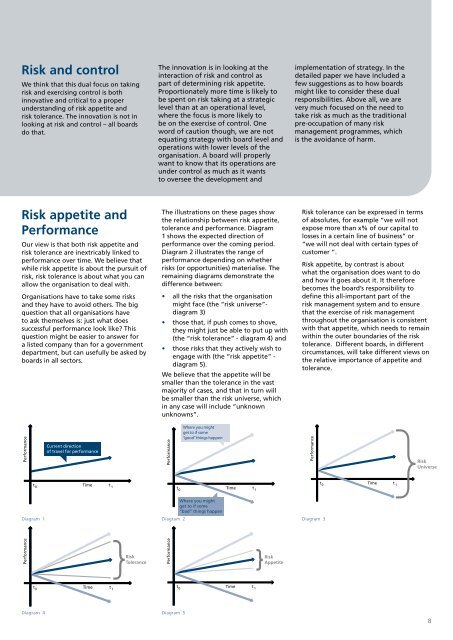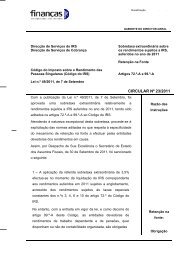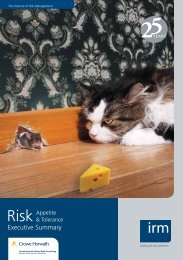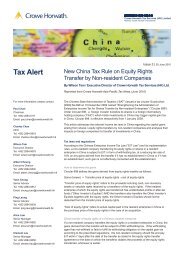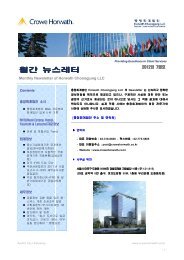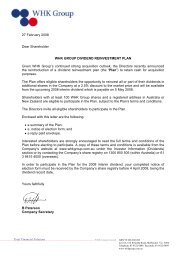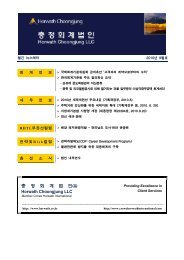Guidance Paper - The Institute of Risk Management
Guidance Paper - The Institute of Risk Management
Guidance Paper - The Institute of Risk Management
You also want an ePaper? Increase the reach of your titles
YUMPU automatically turns print PDFs into web optimized ePapers that Google loves.
<strong>Risk</strong> and control<br />
We think that this dual focus on taking<br />
risk and exercising control is both<br />
innovative and critical to a proper<br />
understanding <strong>of</strong> risk appetite and<br />
risk tolerance. <strong>The</strong> innovation is not in<br />
looking at risk and control – all boards<br />
do that.<br />
<strong>The</strong> innovation is in looking at the<br />
interaction <strong>of</strong> risk and control as<br />
part <strong>of</strong> determining risk appetite.<br />
Proportionately more time is likely to<br />
be spent on risk taking at a strategic<br />
level than at an operational level,<br />
where the focus is more likely to<br />
be on the exercise <strong>of</strong> control. One<br />
word <strong>of</strong> caution though, we are not<br />
equating strategy with board level and<br />
operations with lower levels <strong>of</strong> the<br />
organisation. A board will properly<br />
want to know that its operations are<br />
under control as much as it wants<br />
to oversee the development and<br />
implementation <strong>of</strong> strategy. In the<br />
detailed paper we have included a<br />
few suggestions as to how boards<br />
might like to consider these dual<br />
responsibilities. Above all, we are<br />
very much focused on the need to<br />
take risk as much as the traditional<br />
pre-occupation <strong>of</strong> many risk<br />
management programmes, which<br />
is the avoidance <strong>of</strong> harm.<br />
<strong>Risk</strong> appetite and<br />
Performance<br />
Our view is that both risk appetite and<br />
risk tolerance are inextricably linked to<br />
performance over time. We believe that<br />
while risk appetite is about the pursuit <strong>of</strong><br />
risk, risk tolerance is about what you can<br />
allow the organisation to deal with.<br />
Organisations have to take some risks<br />
and they have to avoid others. <strong>The</strong> big<br />
question that all organisations have<br />
to ask themselves is: just what does<br />
successful performance look like This<br />
question might be easier to answer for<br />
a listed company than for a government<br />
department, but can usefully be asked by<br />
boards in all sectors.<br />
<strong>The</strong> illustrations on these pages show<br />
the relationship between risk appetite,<br />
tolerance and performance. Diagram<br />
1 shows the expected direction <strong>of</strong><br />
performance over the coming period.<br />
Diagram 2 illustrates the range <strong>of</strong><br />
performance depending on whether<br />
risks (or opportunities) materialise. <strong>The</strong><br />
remaining diagrams demonstrate the<br />
difference between:<br />
• all the risks that the organisation<br />
might face (the “risk universe”-<br />
diagram 3)<br />
• those that, if push comes to shove,<br />
they might just be able to put up with<br />
(the “risk tolerance” - diagram 4) and<br />
• those risks that they actively wish to<br />
engage with (the “risk appetite” -<br />
diagram 5).<br />
We believe that the appetite will be<br />
smaller than the tolerance in the vast<br />
majority <strong>of</strong> cases, and that in turn will<br />
be smaller than the risk universe, which<br />
in any case will include “unknown<br />
unknowns”.<br />
<strong>Risk</strong> tolerance can be expressed in terms<br />
<strong>of</strong> absolutes, for example “we will not<br />
expose more than x% <strong>of</strong> our capital to<br />
losses in a certain line <strong>of</strong> business” or<br />
“we will not deal with certain types <strong>of</strong><br />
customer “.<br />
<strong>Risk</strong> appetite, by contrast is about<br />
what the organisation does want to do<br />
and how it goes about it. It therefore<br />
becomes the board’s responsibility to<br />
define this all-important part <strong>of</strong> the<br />
risk management system and to ensure<br />
that the exercise <strong>of</strong> risk management<br />
throughout the organisation is consistent<br />
with that appetite, which needs to remain<br />
within the outer boundaries <strong>of</strong> the risk<br />
tolerance. Different boards, in different<br />
circumstances, will take different views on<br />
the relative importance <strong>of</strong> appetite and<br />
tolerance.<br />
Performance<br />
Current direction<br />
<strong>of</strong> travel for performance<br />
Performance<br />
Where you might<br />
get to if some<br />
“good” things happen<br />
Performance<br />
<strong>Risk</strong><br />
Universe<br />
t 0 Time t 1 t0 Time t 1<br />
t0 Time t 1<br />
Diagram 1<br />
Where you might<br />
get to if some<br />
“bad” things happen<br />
Diagram 2 Diagram 3<br />
Where you might<br />
get to if some<br />
“bad” things happen<br />
Performance<br />
<strong>Risk</strong><br />
Tolerance<br />
Performance<br />
<strong>Risk</strong><br />
Appetite<br />
t0 Time t 1<br />
t0 Time t 1<br />
Diagram 4<br />
Where you might<br />
get to if some<br />
“bad” things happen<br />
Diagram 5<br />
Where you might<br />
get to if some<br />
“bad” things happen<br />
8


